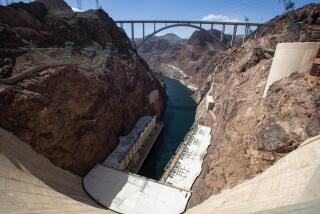DWP officials call for rate hike to cover expenses
The average utility bill for Los Angeles Department of Water and Power customers will need to increase by $19 over the next three years to meet expenses, the head of the agency said Tuesday.
General Manager Ron Nichols said an annual increase of about 5% for both water and electricity rates is crucial to the DWP complying with new environmental requirements and protecting its credit rating.
But the increase would not provide enough to pay for an array of other improvements that are badly needed to help modernize the nation’s largest municipally owned utility, Nichols said. Those improvements include more aggressive water and energy conservation efforts and more rapid replacement of the city’s aging pipelines and power poles.
Because those upgrades are not absolutely necessary and would saddle customers with even higher utility bills, Nichols said, customers and lawmakers should decide whether to fund them.
“It’s a choice,” said Nichols, who detailed the rate increase options for DWP commissioners.
This month and next, customers will have a chance to weigh in on rate hikes during a series of community meetings. The DWP will then present a rate proposal to utility commissioners and the City Council for consideration.
Nichols said he hoped that the new rate structure can go into effect by November. The basic rate hike is vital, he said, because DWP does not collect enough revenue to meet its needs.
“We’re under-collecting today. We’re in a hole today,” Nichols said. “There’s only so long you can do that.”
But Councilwoman Jan Perry said she would not approve rate hikes until after the city hires a ratepayer advocate. In March, voters approved creation of an Office of Public Accountability at the DWP to independently scrutinize rates. The council is expected to form a citizens commission to choose the ratepayer advocate Wednesday, but it could be months until the position is filled.
“I think it would be a folly on our part to begin approving rate hikes after we asked voters to pass this,” Perry said.
Nichols said the DWP charges customers less than most California utility companies. While other California utilities increased electricity rates about 4% per year over the last decade, DWP rates rose by only 2.6%, he said.
Efforts to raise rates in Los Angeles have been contentious in the past. In a bitter public battle with the City Council last spring, the utility threatened to withhold a $73.5-million transfer to the city’s general fund if the council didn’t approve electricity rate hikes.
Those hikes would have meant bill increases of 8.8% for the average residential customer. A compromise was eventually reached when the council agreed to a 4.8% increase.
Carol Schatz, the executive director of the downtown-based Central City Assn., which fought last year’s rate hikes, said her organization has not taken a formal position on Nichols’ current rate hike proposal. But she called it well thought out.
“A year ago there was an effort to shove a very significant increase with no notice down our throats,” she said.
The basic rate hikes proposed Tuesday would mean the average residential customer’s electricity bill would increase by about $4 each year, for three years. The water bill would increase by more than $2 each year. Some revenue from those hikes would pay for mandated shifts to renewable energy. But they would not cover $37 million in outlays needed to upgrade water pipelines or $16 million needed to enhance water conservation programs. They also would not cover $366 million in improvements and conservation projects in the agency’s electricity service, Nichols said.
Evan Gillespie of the Sierra Club said he wished that the rate hike plan contained more money for recycling and energy-saving programs.
“The cheapest form of energy is the energy you don’t use,” he said.
More to Read
Start your day right
Sign up for Essential California for news, features and recommendations from the L.A. Times and beyond in your inbox six days a week.
You may occasionally receive promotional content from the Los Angeles Times.







